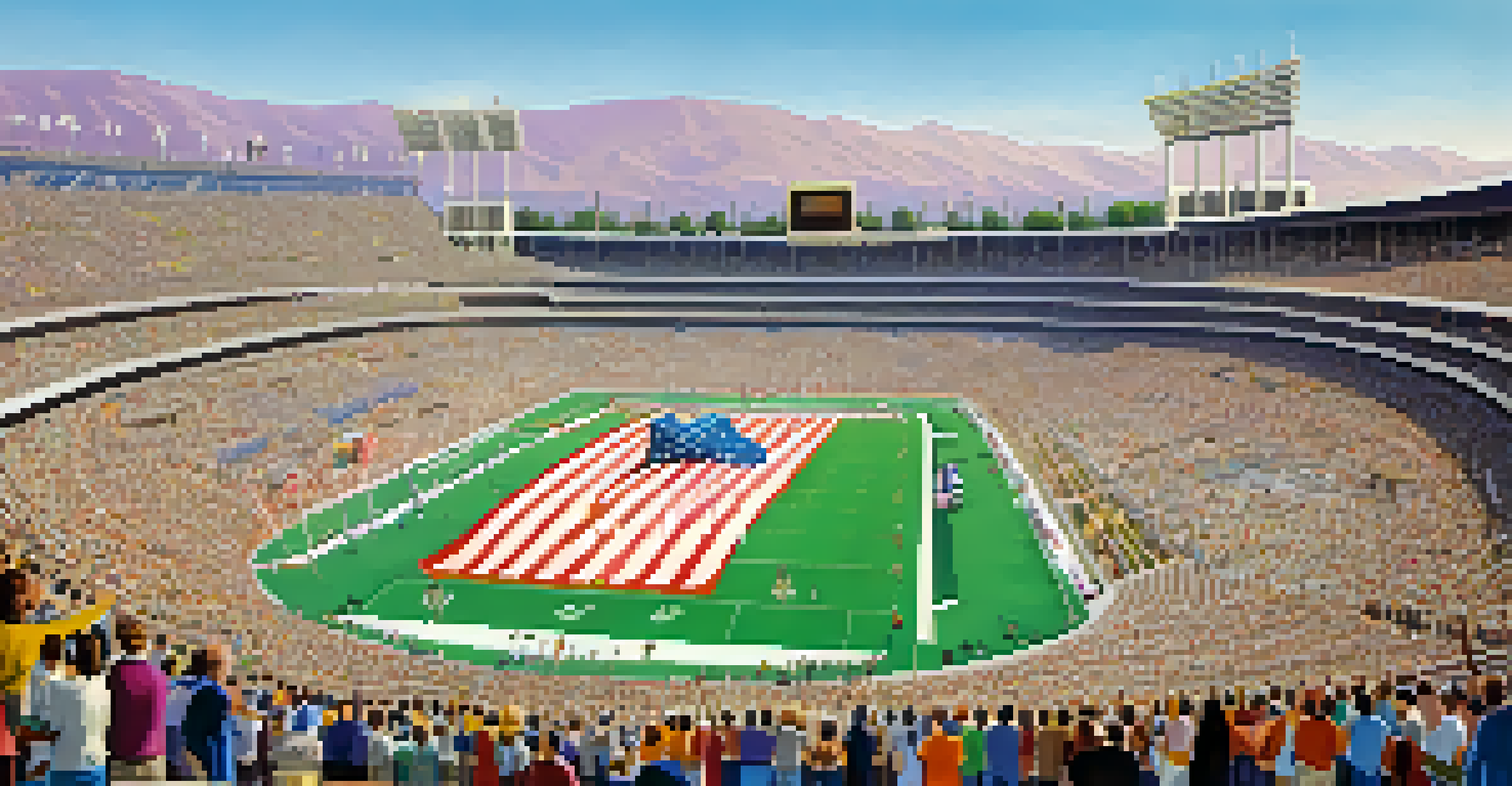The Los Angeles Memorial Coliseum: A Sports History

Introduction to the Coliseum: A Historic Landmark
The Los Angeles Memorial Coliseum, often referred to simply as the Coliseum, is a historic landmark that has been at the heart of sports in Los Angeles since it opened in 1923. This iconic venue has hosted numerous significant events, ranging from the Olympics to Super Bowls, making it a treasure trove of sports history. Its striking architecture and capacity to hold over 77,000 fans make it a remarkable site that has witnessed countless unforgettable moments.
Sports do not build character. They reveal it.
As one of the few stadiums in the world that has hosted the Olympics twice, in 1932 and 1984, the Coliseum holds a unique place in the history of international sports. It also became a significant venue during the 2028 Olympics, showcasing its timeless appeal. The Coliseum's legacy goes beyond just its physical structure; it embodies the spirit of Los Angeles and its passion for sports.
From the cheers of jubilant fans to the solemn moments of remembrance commemorating its namesake, the Coliseum has seen it all. Whether you're a sports enthusiast or a casual observer, this venue tells a story that goes beyond the games played within its walls.
Architectural Marvel: Design and Features
The design of the Coliseum is as captivating as its history. Inspired by Roman amphitheaters, it features a magnificent façade with grand arches and a towering peristyle that adds to its majestic appearance. This architectural style not only sets it apart from other stadiums but also connects it to a rich tradition of sports and competition dating back to ancient times.

One of the most distinctive features of the Coliseum is its peristyle, which is adorned with the Olympic rings and serves as a striking backdrop for events. This area offers a unique vantage point for fans, making it a beloved spot for both spectators and athletes. Additionally, the stadium's natural grass field enhances the viewing experience, providing a sense of connection to the game being played.
A Historic Sports Landmark
The Los Angeles Memorial Coliseum is a historic venue that has hosted iconic events, including the Olympics and Super Bowls, since its opening in 1923.
Over the years, the Coliseum has undergone numerous renovations to modernize its facilities while preserving its historic charm. These updates ensure that it remains a top-tier venue for sports events, concerts, and community gatherings, bridging the gap between its storied past and a dynamic future.
Home of the Trojans: College Football Legacy
The University of Southern California (USC) Trojans have made the Coliseum their home since 1923, creating a rich college football tradition that resonates throughout Los Angeles. With numerous national championships and legendary players, the Trojans have solidified their status as one of college football's elite programs. The atmosphere during game days is electric, with thousands of fans donning cardinal and gold, creating a sea of school spirit.
The only way to prove that you’re a good sport is to lose.
USC's rivalry with UCLA has turned the Coliseum into a battleground for local bragging rights, adding to the excitement of college football in the region. Every year, the annual rivalry game draws immense crowds, showcasing the passion and dedication of both fan bases. This fierce competition has been a defining characteristic of the Coliseum's storied history, contributing to its reputation as a premier college football venue.
Beyond the games, the Coliseum has also hosted the prestigious Rose Bowl, further cementing its legacy in college sports. The combination of tradition, rivalry, and unmatched atmosphere makes the Coliseum a cherished home for the Trojans and a must-visit destination for sports fans.
Olympic Glory: A Global Stage
The Los Angeles Memorial Coliseum's role as an Olympic venue is one of its most defining features, having hosted the Summer Games in both 1932 and 1984. These events brought together athletes from around the world, promoting a spirit of unity and competition that is the hallmark of the Olympic Games. The Coliseum served as the centerpiece for many iconic moments, including the legendary performance of Jesse Owens in 1936 as he dominated the track.
During the 1984 Olympics, the Coliseum once again showcased its ability to host large-scale events, welcoming thousands of spectators for opening and closing ceremonies. The atmosphere was electric as athletes competed for gold, and the city of Los Angeles came alive with excitement and pride. The Coliseum's historical significance during these Olympics helped solidify its status as a global sports hub.
Architectural Marvel and Legacy
Inspired by Roman amphitheaters, the Coliseum's striking design and ongoing renovations blend historic charm with modern amenities.
Looking ahead to the 2028 Olympic Games, the Coliseum is set to play a vital role once again, reaffirming its legacy as a premier venue. This ongoing connection with the Olympics highlights the Coliseum's importance not just to Los Angeles but also to the world of sports.
A Diverse Venue: More Than Just Sports
While the Los Angeles Memorial Coliseum is synonymous with sports, it has also hosted a wide range of events that extend beyond the athletic realm. Concerts featuring some of the biggest names in music have echoed through its halls, drawing massive crowds and creating unforgettable memories. These concerts showcase the Coliseum's versatility as a venue and its ability to adapt to different forms of entertainment.
Political events and rallies have also taken place within the Coliseum, transforming it into a platform for social change and community engagement. These gatherings highlight the venue's significance as a space for dialogue and connection, where voices can be heard and ideas shared. The Coliseum's role in the community extends beyond sports, making it a cherished gathering place for diverse audiences.
In addition, the Coliseum has been a venue for community events, such as charity runs and festivals, solidifying its place in the hearts of Los Angeles residents. This multifaceted approach to programming ensures that the Coliseum remains an integral part of the cultural fabric of the city, fostering a sense of belonging among all who visit.
Memorable Moments: Unforgettable Events in History
Throughout its storied history, the Los Angeles Memorial Coliseum has been the backdrop for countless memorable moments that sports fans cherish. From dramatic last-minute touchdowns to record-breaking performances, the Coliseum has witnessed it all. One of the most iconic events was the 1984 Summer Olympics, where Mary Lou Retton captured the hearts of millions with her stunning gymnastics performances, forever etching her name into the Coliseum's legacy.
Another unforgettable moment occurred during the 1976 Super Bowl, where the Pittsburgh Steelers claimed victory in a thrilling showdown against the Dallas Cowboys. The excitement and energy of that game still resonate with fans today, demonstrating the Coliseum's ability to host events that become part of sports lore. Each event, whether it be a college football game or an Olympic final, adds a chapter to the Coliseum's rich history.
More Than Just Sports Events
Beyond athletics, the Coliseum serves as a versatile venue for concerts, political rallies, and community events, enriching Los Angeles' cultural fabric.
These memorable moments are more than just statistics; they create a tapestry of emotions that connects generations of fans. The stories told within the Coliseum's walls continue to inspire new athletes and entertain audiences, ensuring that its legacy remains vibrant for years to come.
The Future of the Coliseum: Preservation and Innovation
As we look to the future, the Los Angeles Memorial Coliseum faces the challenge of preserving its historic significance while embracing modern innovations. Recent renovations have introduced state-of-the-art technology and improved amenities, ensuring that the Coliseum meets the expectations of today’s audiences. This balance between tradition and modernization is crucial for maintaining its relevance in a rapidly evolving sports landscape.
Plans for future events and continued community engagement reflect a commitment to making the Coliseum a hub for sports and culture. By hosting diverse events and fostering partnerships with local organizations, the Coliseum aims to strengthen its ties with the community. This forward-thinking approach will help the venue remain a beloved destination for generations to come.

Ultimately, the Los Angeles Memorial Coliseum stands as a testament to the enduring power of sports in our lives. Its ability to adapt while honoring its past ensures that it will continue to inspire and entertain, making it a cherished symbol of Los Angeles for years to come.